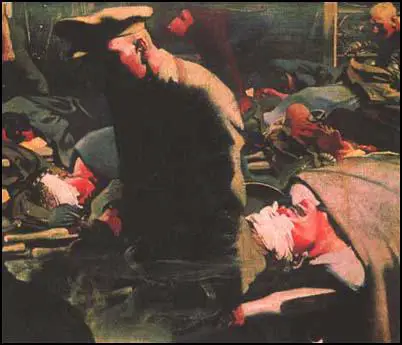Eric Kennington
Eric Henri Kennington, the second of the two sons of Thomas Benjamin Kennington (1856–1916) and his Swedish wife, Elise Nilla Lindahl Steveni (1861–1895), was born in Liverpool, on 12th March, 1888. His father was a portrait painter and an active member of the New English Art Club. Educated at St. Paul's School and the Lambeth School of Art, Kennington first exhibited at the Royal Academy in 1908.
His biographer, Julian Freeman, has argued: "A vital, independent talent in early and mid-twentieth-century British art, Kennington became a formidable draughtsman-painter, printmaker, and sculptor (his working practice evolved roughly in that order), and a great portraitist: his figures were often somewhat idealized, but always boldly executed, and frequently in pastel crayon, a self-taught medium in which he came to excel."
On the outbreak of the First World War Kennington enlisted with the 13th London Regiment. He fought on the Western Front but was badly wounded and and sent home in June 1915. During his convalescence he produced The Kensingtons at Laventie, a portrait of a group of infantrymen. When exhibited in the spring of 1916 its portrayal of exhausted soldiers created a sensation. It has been claimed by Campbell Dodgson that Kennington was "a born painter of the nameless heroes of the rank and file".

Kennington was invalided out of the British Army and in August, 1917, he was employed by the War Propaganda Bureauto produce pictures of the Western Front. Kennington's paintings, pastels and lithographs include Gassed and Wounded, The Die-Hards and Back to Billets. After the war he also designed many war memorials.
In 1922 Kennington went with T. E. Lawrence to Arabia where he produced pastel drawings of Arab leaders. In 1926 he became art editor of Lawrence's The Seven Pillars of Wisdom. In the 1930s he concentrated on his work as a sculptor.
Kennington was also an official artist during the Second World War. During this war he confined himself chiefly to pastel portraits of sailors and airmen. Julian Freeman points out: "Kennington's detailed drawings and paintings of steely-eyed airmen, seamen, and soldiers made in 1939–42 for the War Artists' Advisory Committee during the Second World War were not always appreciated."
Eric Kennington died on 13th April 1960, at 16 Bath Road, Reading, after a long battle with cancer, and was buried in the churchyard at Checkendon.
